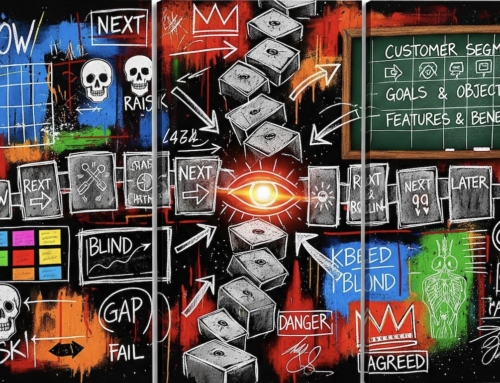
We Will Outshine the Competition – Interview with Nazarena Garrón Ciberay from the Scrum Alliance
 Wonder what is in store for you after a Certified ScrumMaster (CSM) or Certified Product Owner (CPO) class? How do you become a Certified Scrum Professional (CSP)? Or what are the steps to become a Certified Scrum Trainer (CST)? This month we speak with the woman whose job is to come up with credible answers to these questions, define an easy-to-understand path for you to reach these goals and explain the value proposition of continuing your education in Scrum with the Scrum Alliance. Nazarena Garrón Cibery is the Education Director of the Scrum Alliance and, as it turns out, she is also the Product Owner for that program at the Scrum Alliance.
Wonder what is in store for you after a Certified ScrumMaster (CSM) or Certified Product Owner (CPO) class? How do you become a Certified Scrum Professional (CSP)? Or what are the steps to become a Certified Scrum Trainer (CST)? This month we speak with the woman whose job is to come up with credible answers to these questions, define an easy-to-understand path for you to reach these goals and explain the value proposition of continuing your education in Scrum with the Scrum Alliance. Nazarena Garrón Cibery is the Education Director of the Scrum Alliance and, as it turns out, she is also the Product Owner for that program at the Scrum Alliance.
- What did you do before coming to the Scrum Alliance? Why were you interested in working for the Scrum Alliance? I’ve always worked in education. Most recently and before joining Scrum Alliance, I was part of Denver Public Schools, an emerging national leader in urban education reform and teacher effectiveness. My team worked to assure that quality educators had access to and clear requirements around tailored and impactful, ongoing professional development. Due to an opportunity presented to my husband, our family relocated to Cincinnati, Ohio. Although it was an exciting move for us, I knew it would be difficult to once again find something to invest my time and energy into that would offer the same level of satisfaction. I mean, I was living Whitney Houston’s lyrics – “I believe the children are our future” – and I was helping teachers prepare to “teach them well and let them lead the way.” When I heard about the Scrum Alliance and learned of their vision, “Transforming the world of work”, I was curious and hopeful. I’ve been fortunate to find a new future. Now I’m part of an amazing community that will “teach them Scrum well and let them lead the way.”
- What is your main goal at Scrum Alliance? As more and more organizations realize the success Agile practices render, our members must feel confident in the excellence and integrity of their certifications. I am committed to inspecting the policies currently in place and improving them in a way that considers the growing needs of our certified members and tailoring our programs to support our members. Our certifications must accurately represent their knowledge and skills to the Scrum community, potential clients, and\or future employers. As more professionals and professions seek out Scrum, we will be prepared to outshine the competition and continue to be the place where people come to talk and learn about Scrum.
- Tell us about the new CSP program. Why people should be interested in it? Ongoing efforts to capture the essence of a CSP continue to lead our process. We feel confident in currently having a way to proportionally balance the areas that showcase the seasoned experience a CSP should possess. The process has two main areas of requirements: experience, or how long an individual has held Scrum roles; and education, what development they have sought out and benefited from. CSM, CSPO and Certified Scrum Developers (CSD) should be interested in acquiring their CSP because it represents their additional experience and training and makes them distinguishable in a crowd of applicants. Hiring managers will seek CSP due to the added value the certification holds as a way to validate their requirements around experience.
- I am told that Scrum Alliance has set an ambitious goal – more than triple the number of CSP in the next five years – for the CSP. Why has Scrum Alliance made this commitment? What are the plans to support this goal? The best way to explain our audacious goal is through sharing our intent – we are not interested in a number. What interests us is the united effort, alongside our members, to be innovative thinkers, as well as the need to strengthen and improve our partnerships and communications. The goal, in fact, is to act as a cohesive unit and do so with courageous integrity for those who will benefit from the well-deserved value enhancement of the certification. A lot is still in planning and development as we begin this journey. We will be hosting Voice of the Customer interviews with CSP holders. We are also planning marketing efforts for 2014 to raise the visibility of this certification among employers, as well as researching ways to reposition the credential as something stronger.
- What is an SEU? How do people earn them? An SEU, or Scrum Education Unit, is a measurement of credit ascribed to learning opportunities designed to assist Scrum practitioners in attaining, retaining, and developing a certification. There are various ways to earn SEUs. The umbrella concept is to invest time in courses, conferences, research, authoring, etc., that result in deepening your experience as a Scrum practitioner.
- What has you most excited about the Scrum Alliance? I’m excited about the true transformation and impact that spreading the work of Scrum has on teams and projects. I’m excited about the promise of Scrum in other professions: education, medicine, government. . . The Scrum Alliance is made up of strong players – a capable and willing body of leaders have partnered with an invested group of members, all committed to a common goal. It’s quite a synergy. I am excited about the growing trust and collaboration between the two. I am most excited about being part of a community that embraces courage, which allows someone in my place to face the possibility of failure with curiosity in place of fear.
- What is the biggest challenge you face right now in your role at Scrum Alliance? Time is my biggest challenge. I have learned that as Product Owner, it is my responsibility to say “no,” but there is so much to do and so many willing and able individuals wanting to help. It’s difficult to push projects “below the line.” I am however, convinced that in order to achieve them and be successful, I must discern, say “no” appropriately and groom effectively.
- How has the Scrum coaching from Brad Swanson impacted the way you work? Brad’s ability to translate Scrum into what I claimed to be my “unique” situations, along with his consistent reminder of clean Scrum practices, has helped focus my work. It’s easy to fall back into old work routines. He is a reminder of why it’s worthwhile to adopt and adapt Scrum to succeed in work. What makes this impact long-term is his patience in allowing me to find the answer on my own. He is a true Scrum Coach! I am fortunate to work with him.
- Any advice you want to share with people about adopting Scrum for non-software teams? Agree to embrace the idea of “good enough” as well as to accept the possibility of failing. These proved to be most transformational for me. It makes so much sense to identify MVPs (minimum viable product – another huge lesson our coach, Brad Swanson, has instilled in us). Don’t continue to attempt perfection. It can’t be perfect until you hand it to the users and see what’s useful to them. Finally, be prepared and committed to inspect-and-adapt!





